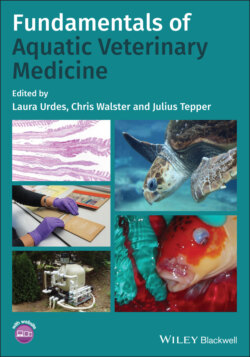Читать книгу Fundamentals of Aquatic Veterinary Medicine - Группа авторов - Страница 31
1.3.2.4 Dissolved Oxygen
ОглавлениеDissolved oxygen monitoring is critical in aquaculture. Temperature, salinity and elevation affect dissolved oxygen. As these three factors increase, dissolved oxygen at saturation decreases. For example, the cold temperature of the Antarctic results in higher dissolved oxygen concentrations compared with warmer tropical waters. Freshwater at sea level holds 9.2 ppm at 20°C and 7.6 ppm at 30°C. Fish become more active and increase their metabolic oxygen needs as temperature increases. As temperature rises, fish also need more dissolved oxygen to grow muscle tissue. Minimum tolerable dissolved oxygen levels increase with a rise in temperature.
In general, most fish species will grow and thrive within a dissolved oxygen range of 5–12 mg/l (parts per million). However, if levels drop below 4 mg/l they may stop feeding, become stressed and begin to die. Dissolved oxygen ranges for cultured fish are as follows:
0–2 ppm – small fish may survive a short exposure, but lethal if exposure is prolonged. This range is lethal to larger fish.
2–5 ppm – most fish survive, but growth is slower if prolonged; may be stressful; aeration devices are often used below 3 ppm.
5 ppm to saturation – the desirable range for all.
With rainbow trout, the minimum lethal limit is 1.6 ppm at lower temperatures and 2.5 ppm at higher temperatures.
Oxygen and pH are best measured in situ (with probes) or as soon as possible after collection (preferably before leaving the site) as, in most situations, levels will change during storage and transport.
Biological oxygen demand is a measure of the oxygen used by all organisms in an aquasystem.
